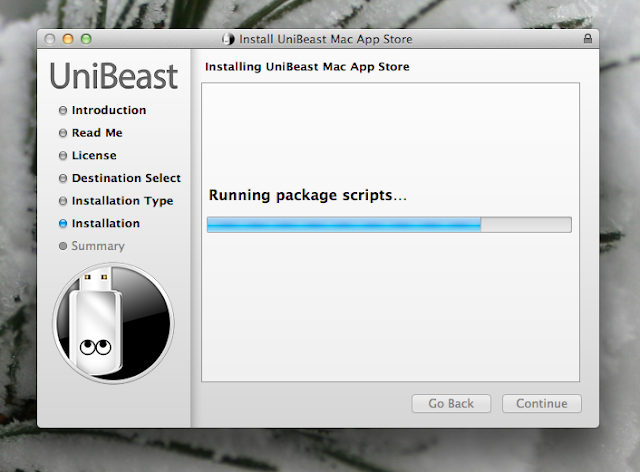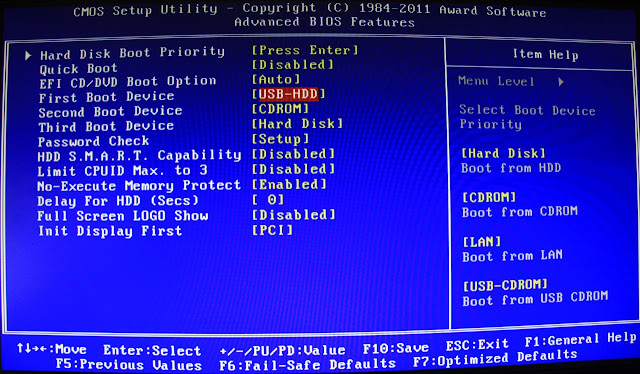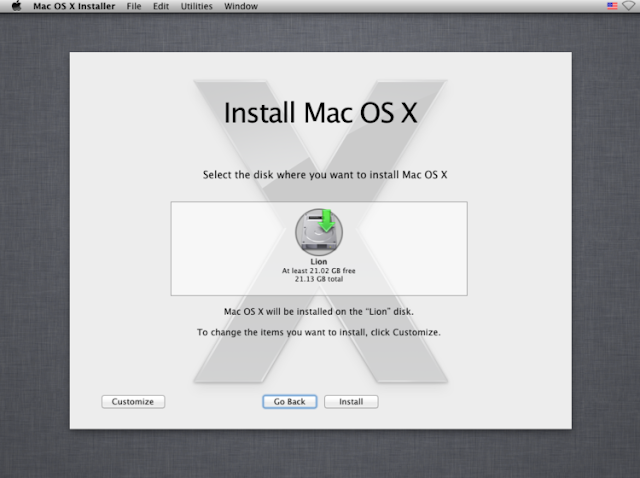 If you're interested in running Mac OS X, but you don't want to pay ridiculous prices for a normal Mac, then a Hackintosh just
might be for you. Right now, the newest iteration of OS X is 10.9,
known as Mavericks. Installing Mavericks on a PC is pretty much the
exact same as installing Mac OS X 10.8 (Mountain Lion). This guide will follow tonymacx86's standard Unibeast method, except that we try to cover the process with more detail (and pictures!).
If you're interested in running Mac OS X, but you don't want to pay ridiculous prices for a normal Mac, then a Hackintosh just
might be for you. Right now, the newest iteration of OS X is 10.9,
known as Mavericks. Installing Mavericks on a PC is pretty much the
exact same as installing Mac OS X 10.8 (Mountain Lion). This guide will follow tonymacx86's standard Unibeast method, except that we try to cover the process with more detail (and pictures!).Requirements:
- A compatible computer: Not every computer will work with Mac OS X, even with the help of tools like Unibeast and Multibeast. Be sure to read the Hackintosh compatibility guide very carefully, to check whether or not your computer qualifies. The hardware requirements for OS X Mavericks are identical to those for OS X Mountain Lion; AMD processors and older 32-bit Intel processors (such as Pentium M) are not supported. If your computer already has OS X Mountain Lion installed, Unibeast will just update Mountain Lion to Mavericks normally, without deleting any of your apps or files.
- A separate hard drive: Mac OS X needs its own hard drive (a minimum of 10 GB of space is required, but at least 50 GB of space is recommended). Unibeast will not work on a hard drive where Windows was installed first. You can bypass this requirement by applying the MBR patch to Unibeast (the process for Mavericks is the exact same as for Mountain Lion).
- Unibeast (Free): Unibeast is a Mac program that modifies the official OS X Mavericks installer, and writes it onto a USB drive. You can then use this Unibeast USB drive to run the Mavericks installer on a PC. Unibeast works with Mac OS X Snow Leopard and newer; registration on tonymacx86.com is required to download Unibeast.
- A Hackintosh with Snow Leopard/Lion/Mountain Lion already installed, a real Mac, or a Mac OS X virtual machine: Unibeast is a Mac app, so you need a computer with Mac OS X to run it. You could use a real Mac, if you own one. Alternatively, you could install Mountain Lion on a virtual machine, and run Unibeast on there instead. Be sure to install the Virtualbox Extension Pack to view USB drives from your virtual machine.
- OS X Mavericks (Free): The method used by this guide requires that you download a free copy of the Mavericks installer app from the Mac App Store. Though the Mac App Store is included in Mac OS X 10.6.6 and newer, you have to be running 10.6.8 to download Mavericks. (you might be able to circumvent this requirement by spoofing your system version).
- An empty USB drive (8 GB or larger): The USB drive used for Unibeast must be at least 8 GB in size. Since Unibeast will erase all of the files on your USB drive, make sure to back up its contents first. You can reuse this USB drive for normal stuff after you finish installing Mavericks.
- Multibeast (Free): Multibeast is a collection of kext files that your Hackintosh will need to run properly, after the initial installation. Download it onto a USB drive. Be sure to download the newest version 6 of Multibeast, not the older versions 3, 4, or 5.
1. Format your USB drive for Unibeast
Plug your USB drive into Mac OS X, and open Disk Utility (located in the
Utilities folder in the Applications folder). Select the USB drive in
the sidebar of Disk Utility, go to the "Partition" tab of Disk Utility.
Click the "Options" button, and check the partition scheme: it should be
set to "Master Boot Record" by default.

Then, create a new partition layout with 1 partition. Set the format to
"Mac OS Extended (Journaled)". Name the new partition whatever you want
(I named mine "Cheesecake"), and click "Apply".

This will erase and reformat your USB drive so that it's ready for
Unibeast. The process should only take a few seconds to complete.
2. Run Unibeast




3. Set up the parts of your PC
Before you begin your Mavericks installation, make sure to follow these procedures:
- Unplug all USB-connected devices from your computer before you begin the setup (except your keyboard and mouse). A faulty external USB hard drive can cause your Hackintosh bootloader to give you EBIOS errors on startup.
- Open up your computer and unplug any extra internal hard drives that your computer has, besides the hard drive that you're installing OS X on. (Just unplug the hard drive SATA cables from your motherboard.)
- If your computer uses a discrete (separate) graphics card, unplug that card from your computer motherboard and use the integrated graphics on your CPU instead (assuming your CPU actually has integrated graphics). Doing this will reduce the number of possible points of failure in the guide-- Mac OS X tends to have a lot of problems with discrete graphics cards during the setup process.
- If possible, connect your monitor to the DVI port of your computer's integrated graphics. The Mac OS X installer sometimes has problems with HDMI and VGA.
NOTE: If you're installing Mac OS X on a computer that already
has Windows installed on a separate internal hard drive, you may have
to enable AHCI for Windows beforehand. Otherwise, Windows won't boot afterwards. Also, after installing Mac OS X, you should also sync your clock on Windows with Mac OS X.
4. Set up your motherboard's BIOS
The BIOS is basically a settings page for your motherboard. To enter the BIOS on my own computer's Gigabyte P67A-D3-B3 motherboard, I have to press the delete key when it boots (before the operating system starts). Different manufacturers set different keys for opening the BIOS.
NOTE: If you have a newer Gigabyte motherboard that uses the UEFI interface instead of BIOS, check out our guide for setting up the UEFI instead. New motherboards with the LGA 1150 socket (the boards that support Intel "Haswell" processors) generally don't need much tweaking at all.

If your Hackintosh doesn't have any version of Mac OS X installed yet, you have to change a few extra BIOS settings. Before starting, reset all of your BIOS settings to their factory defaults. On Gigabyte motherboards, you can reset your BIOS settings to their default by selecting "Load Optimized Defaults" on the main page of the BIOS. Once your BIOS is running on its defaults, you need to change these three settings:
Boot Device - Change the boot device of your computer so that "USB-HDD" is first. You need to do this for Unibeast to work. After you finish installing Mac OS X, you should change this setting back to default, so that "Hard Disk" is the first boot device (this optional, but it will speed up your boot times).



5. Boot into Unibeast
Restart your Hackintosh, and plug in your Unibeast USB drive. If things go well, your computer will boot from the USB drive instead of booting from your normal hard disk. You will then be able to view the Unibeast menu.

At the Unibeast menu, select the name of your Unibeast USB drive, by using the left/right arrow keys on your keyboard, and then press the enter key (or return key) to start the OS X Mavericks installer.

To enter boot flags, manually restart your computer by pressing your computer's power button. Then, once you've booted back into the Unibeast menu, try typing any necessary boot flags before pressing the enter/return key. Check out this list of common boot flags for reference ( PCIRootUID=0 and -x are two popular boot flags).
6. Install Mavericks
Continue, and you will eventually come up to a page that asks you for a
"destination" for your Mac install. Select the hard drive that you want
to install OS X Mavericks on, and continue.
Otherwise, select the hard drive you want to install OS X Mavericks on, and click "Install". Mavericks will now install itself. This will take at least 30 minutes.
Restart. If your Hackintosh already had Mac OS X Snow Leopard, Lion, or Mountain Lion installed beforehand, you can unplug the Unibeast USB drive. Otherwise, keep the USB drive plugged in. At the boot screen, you'll see an icon for the hard drive where you installed Mavericks. Select it (use the arrow keys on your computer) and press "Enter".


To enter boot flags, manually restart your computer by pressing your computer's power button. Then, once you've booted back into the Unibeast menu, try type any necessary boot flags before pressing the enter/return key. Check out this list of common boot flags for reference ( PCIRootUID=0 and -x are two popular boot flags).
7. Multibeast
Multibeast is a collection of kext files that you'll need to install for your Hackintoshes to have sound, internet, a high resolution screen, and more. Different Hackintosh builds require different Multibeast setups, though most setups are very similar. Find out what Multibeast options you need to install. If you have a Gigabyte GA-P67A-D3-B3 motherboard like me, check out my own Multibeast setup.

Once that's done with, you should be running a fully functional copy of OS X Mavericks on your PC. If you plan on updating Mac OS X in the future, check out our guide to updating your Hackintosh. Congratulations!
Tech Learning: How To Install Os Mavericks On Your Pc With Unibeast >>>>> Download Now
ReplyDelete>>>>> Download Full
Tech Learning: How To Install Os Mavericks On Your Pc With Unibeast >>>>> Download LINK
>>>>> Download Now
Tech Learning: How To Install Os Mavericks On Your Pc With Unibeast >>>>> Download Full
>>>>> Download LINK